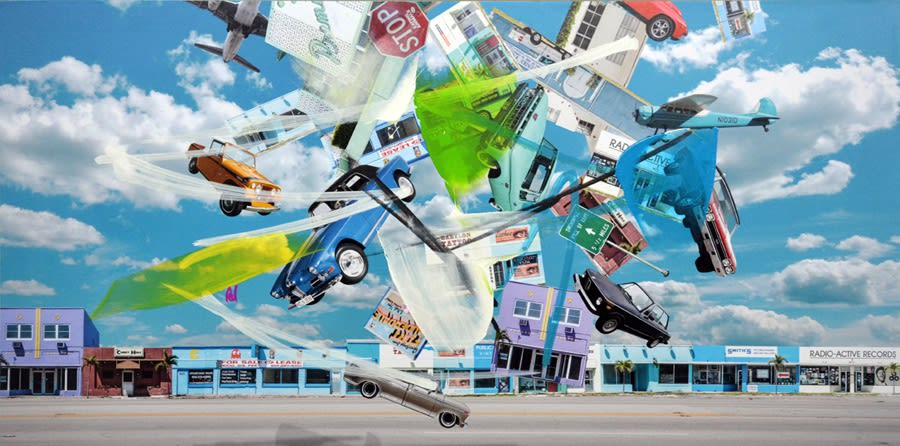
“The Photograph does not necessarily say what is no longer, but only and for certain what has been”.
– Roland Barthes, “Camera Lucida: Reflections on Photography”
Every two years, photographers, collectors, curators, publishers and photography lovers meet in Houston to share, network and see multiple exhibitions at the FotoFest Biennial. This commentary will focus on six exceptional photographers, from different countries and very diverse backgrounds, who used photography in a special way. The works of these photographers, Paul-André Larocque, Robert Langham III, Fabio Del Re, Lucas Lenci, Teri Havens and Marcus Lyon were seen at FotoFest 2018 and provided an interesting perspective in the use of photography. Each hold a unique vision that help us, the viewer, see the world differently. These artists embrace a concept of time in their work. They reflect time from a single moment to a passage through millenniums. In expressing their unique vision through photography-based art and mixed mediums, our sense and concept of time is broadened and deepened.
A photograph is traditionally thought of as an image created by the capture of light onto a light sensitive material. The photogram is the most simplistic way of capturing nature, or a part of our world, on material as a faithful reproduction of an object. A single moment captured. A material, like paper coated with light sensitive chemicals, is merely exposed to sunlight, or an artificial light source, with an object placed on it which blocks part of the light from hitting the treated paper surface. The shadow of that object appears as white on the unexposed portion of the surface. The exposed portion turns a color, whether black, or blue as in a cyanotype. Through the use of a lens, or the mechanics of a “pinhole”, an image of our surroundings is captured on this light sensitive surface in a different and more complete manner. The use of digital technology is another change to how images are captured. All of these techniques are tools used by photographic artists to record and present to the viewer our world at a moment of time.
Artists, however, are not always capturing our world literally. An artist reinterprets the world. Their art is a visual expression of how they see it or want us to see it. While each artist’s creations are unique, the manner of creating the imagery may not be. That photographic record, combined with what is subsequently done with that image, and how it reflects the passage of time, is what separates one photographer from another. Photographers can manage the use and capture of light, the materials on which the captured image is recorded and the manner in which the image is printed or assembled into a visual object to create a different way for the viewer to see and think. While the possible combinations and permutations of these choices are infinite, some of the basics to the what and how may not have changed as much as one might imagine. The choices made, from amongst all possible techniques, make these artists different.
Montage, the assembly of multiple images into one picture, is the technique used by Paul-André Larocque to give momentum and energy to his “POP” series of images, that he refers to as “Tornado Accumulations”. There is “Candy POP”, “Desert POP”, “Fair POP”, “Motel POP” and “Sunshine POP”. Photography has a long history of photographers enhancing what we see in the world by combining images. Gustave Le Gray did it in mid-1800s to give a more realistic photographic presentation of sky and earth in one image. Oscar Gustave Rejlander used a combination of negatives to create an imagined allegorical montage, “The Two Ways of Life” in 1857. Larocque uses similar techniques to create his “POP” images.
A French Canadian, now living in Florida, Larocque created an intricate fictional landscapes and cityscapes with a swirl of objects rising in a tornado like twist into the air. Each object is one he has photographed while on assignments, combining a life as an artist with one as a journalist and freelance photographer. None of the images are appropriated. Larocque applies touches of paint to add texture to the montage. The use of other media in photography follows another long tradition in art. The free flowing brush strokes of paint add a visual emphasis that move us further from a traditional photograph to a wild mixed media art object. The work confronts and envelopes the viewer. None of the images are capturing a specific event or place or moment. In Larocque’s work, the concept of time is totally disregarded, confused and blended by his selection of images.

It is almost impossible not to engage with the image. One cannot ignore the settings of a beach, a town, a city or a person, as the back drop to the swirling collection of images. In some of the images, he adjusts scale to both give depth to the image and to make the objects appear to rise off and out of the image. The images are bright and festive colors in a sort of carnival atmosphere. Each scene has an appearance of place; yet, is a complete fabrication.
Robert Langham creates black and white silver gelatin “Tornado” images recorded on film and hand-printed in his own darkroom. Using film forces a slow down in one’s approach to image making. Langham takes it slow. His images, however, have a visual intensity and sense of energy. These images reflect Langham’s interest in the studio created still life. His prior “Blackfork Bestiary” series focuses on animals, alive and gently handled, brought to his studio by town folk that know of his interest in photographing the nature around us. Langham is also well known for his western landscapes of isolated mountains and mesas around Shiprock, New Mexico. In the “Magic & Logic” portfolio, he creates imaginative sculptures of fruit, vegetables, ice, books, metal, candles and other found objects which he combines and photographs. The newest “Tornado” work attests to Langham’s restless active mind and a deep-seated motivation to create. It is very different from the digital capture and style of printing used by Larocque, but nondescript as to a moment in time or place.
The “Puzzle Tornado” is framed around seemingly blank puzzle pieces following a double helix of barbed-wire through a swirling white cloud of apparent motion. It seems an apt metaphor for what life holds for us: confusion, activity, prickliness with highs that carry us up precariously only to drop us down when we topple or fall off our momentum. Langham has said: “I’m passionate about landscape and the life it generates. The flora, fauna, and the intersection of human culture and the earth is where I look for my images”. Similar images were created with feathers, bones and fallen leaves. There is always a secret in his images to be discovered, and he will not share what surprise he has embedded into the images. In this newest tornado series, the swirl is the mysticism in life. The swirl motion may be that life force he seems to measure by the tight whirr of wind as it appears in these images. The objects he uses are the defining focus of each photograph. For Langham the bones, feathers, dried leaves and other objects he incorporates are part of a life cycle, symbolic of our aspirations. The puzzle pieces perhaps reflect our ability to think, rationalize and work out problems. The tornado series takes ordinary objects and makes their examination a special pleasure. Despite the creation of this work in a studio setting, Langham’s work might hardly be viewed as a “still life”, while in fact, it may just be that. This contradiction is a complement to his East Texas humor and life style.
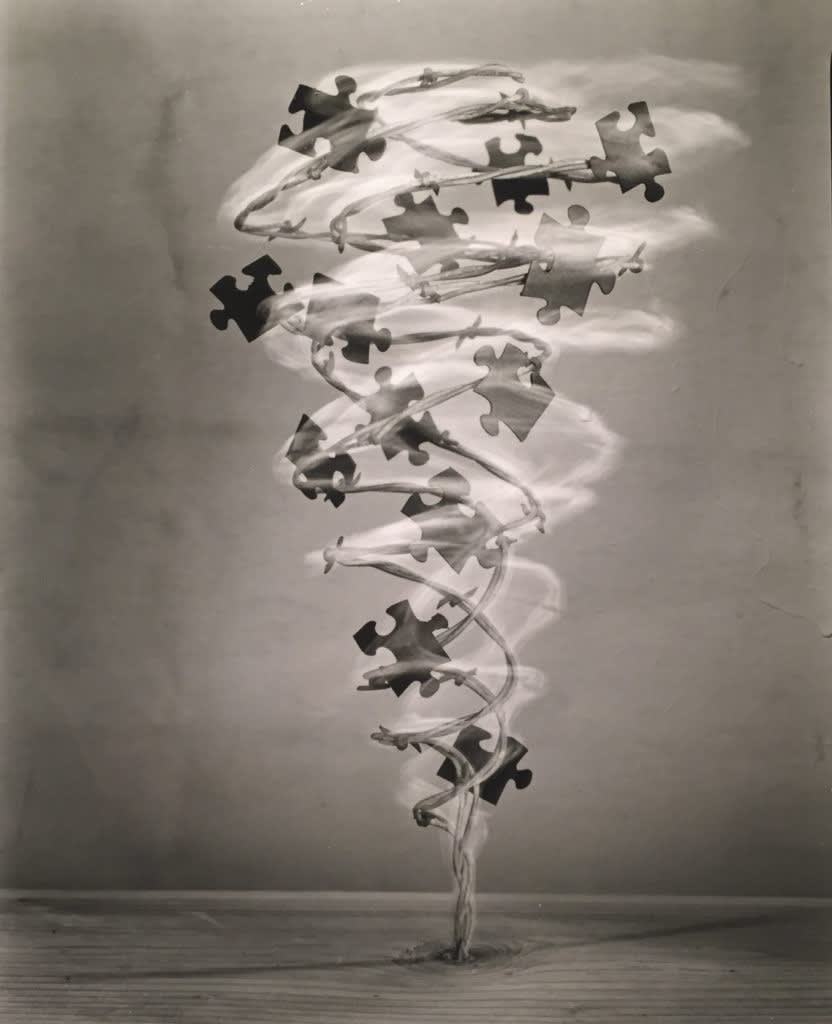
Brazilian photographer Fábio Del Re created his “Monte Belo” series from found objects in an old cellar. These images are created in a style very different than the other photographers mentioned previously. Del Re evidences human activity without people, place or passage of time. Unlike Robert Langham’s work, there is no motion embedded into Del Re’s still life work. In a sense, a different type of motion. The objects stand as a statement of the passage of time without illustration of movement. Del Re commented: “scattered around were some empty wooden barrels, tools, a table, chairs, boxes, boots and bottles. What was once a family wine cellar was now a place to store useless objects that I suppose haven’t been definitely thrown away due that old excuse we usually have that they may be useful one day. They are objects which still carry the expectation of being useful in a future that had been near one day. Right there in the cellar I started to arrange them, to build small groups with these “lids” that immediately made me smile. I asked politely to take them with me and this is how the “Monte Belo” series came up – a tribute to the city where this house is located. These photographs/lids carry something incredibly familiar, even if we do not comprehend what the objects are? They induce some sort of recognition, not the kind “I have seen this before”, but one of “I’ve already lived this before…”.”
Del Re has a consistent style throughout his other work – “Funis”; “Caí”, “Caderno Reproduzir” and “Morandi”. A description of Del Re’s “Morandi” work by Luisa Kiefera, an independent Brazilian Curator, on his website, is relevant to appreciating the “Monte Belo” images: “It was not the still life that he was interested, but the issues Morandi’s paintings brought up, such as the relation between the objects and the background, the discreet volume, the layers of paint, and the handcraft presence. A painting that is soothing, with quiet colors that feels like it is stretching in time, or even occupies another time. A painting that persists in our memory in a quiet form. Overwhelming but familiar, almost as if it has always been there."
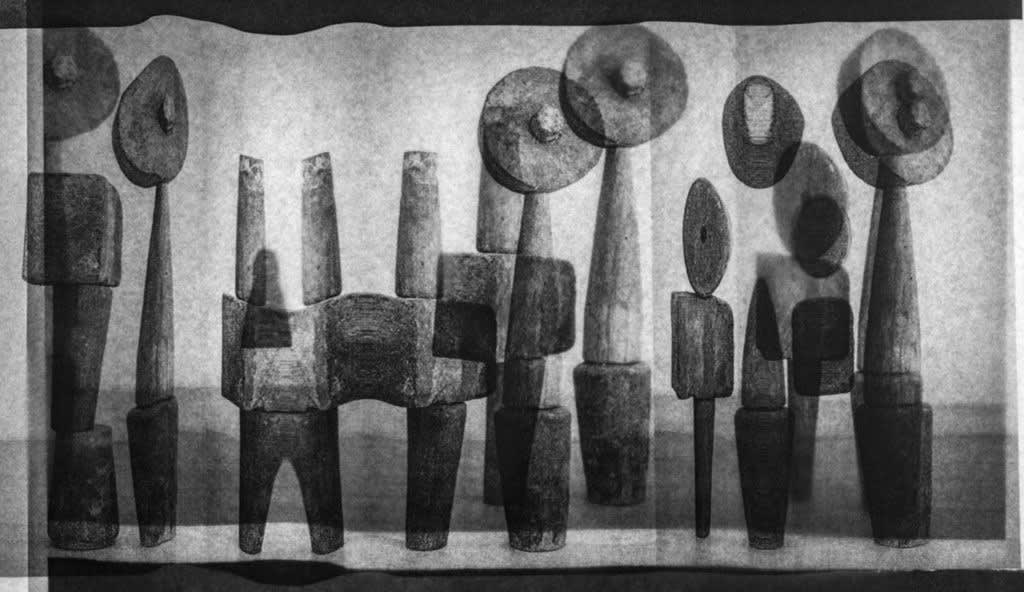
There is also a special appearance to each of the images. While the images are photographic, they have a charcoal/graphite drawn look. The appearance of these images is unlike any others using a photographic medium. There appears to be a layering of several images. In some, the objects appear to have been placed differently. If there was a background, it appears to have moved or rippled. As the different files or negatives were layered, the artist did not appear to lay one image precisely over the other. There appears to be a very intentional misalignment. It is this misalignment that makes us pause to engage studying objects from a time that has clearly past.
Lucas Lenci, a Brazilian photographer, captures time through motion and movement in a style all his own. His series “Movimento Estatico (“Static Movement”)” is a very different aggregation of photographs taken in single place that are combined into one image. The title of this body of work is misleading. The images have an ebb and flow that defy the word “static”. Lenci’s works are a rhythmic whirlwind of life activity taken within a defined space in stark black & white. “How do we occupy time and space? That question led me to start the “Static Movement” project,… Between 2014 and 2016, I photographed several cities, such as Paris, New York, Lisbon and São Paulo. In each of them, I stood at a certain location, over many hours, with the camera on the tripod, and I captured the different interactions occurring at a same location.” In stitching the images together, the halls and building background wave and become a stage with different people moving through it. The backgrounds are aquariums, ski slopes, street scenes, buildings and a variety of other spaces. All these spaces have unique visual attributes that the people appear to weave and wander through, whether on foot, skis, bicycle dressed casually, or as tourists, for sport or formally. It is an intriguing and different way to engage us in an examination of our daily selves.
The work is outside of a studio setting. Lenci’s images are a study of our motion within the outdoor environment – whether city, countryside or mountains. There are street scenes, bicycles, walkways, buildings, runners, scooters, but always people. People moving through the images make the images intriguing. We never seem to tire of people watching, whether at a street side cafe or within a photograph. In some images the same people or group of people are captured multiple times in different poses. In other images, the people are all different as some move out of the camera’s field of vision, and others enter. These are the opposite of a still life. The photographer is still, but life is on the move.
Lenci combines multiple images into one image differently than the previous artists. His work is an “assembled” image. Lenci commented that there are “a combination of over 24 photographs. The repetitions give the impression of continuance and these celebrate the infinite”. The scenes are “stitched” together. Unlike a montage image, as with Larocque’s work where the images are layered onto one another, Lenci’s are placed laterally and vertically together. A viewer engages with the images reading them left to right, or right to left or top to bottom or bottom up. In other works, the viewer has a very frontal dive into the middle; a visual sense as the images explode for the center weight of the image. Lenci’s work confronts the viewer across the entire span of the image. It’s a visual assault. The image emerges from the trenches reaching across a no-mans land that he has redefined and manipulated to flow visually in a way very different way. The motion the viewer senses is like watching waves on the ocean from the beach. The scenes ebb and weave, the people are in motion, but we, the viewers, do not move, except for our eyes which are in constant motion across the images.
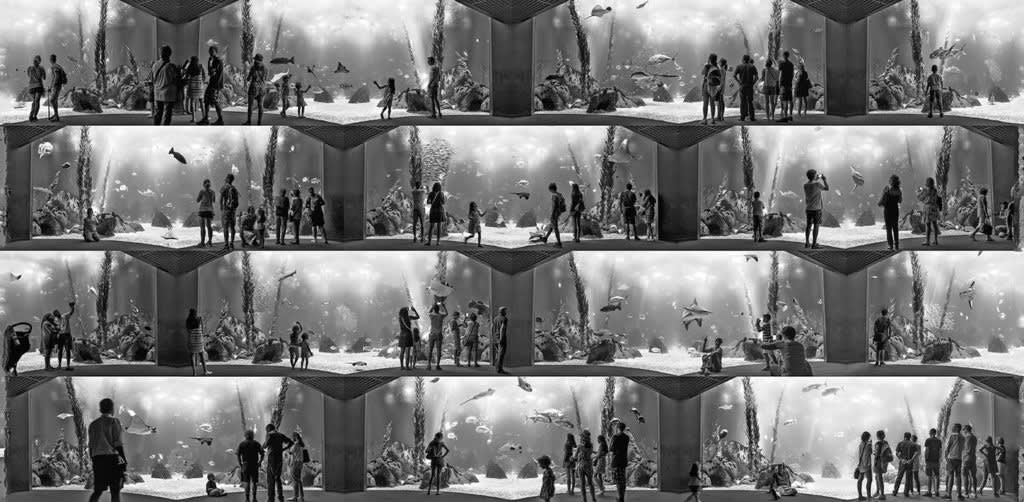
Theresa “Teri” Havens, an American photographer living in Colorado, creates images of life at rest enveloped in darkness. While the other images previously discussed involve a combination of images, hers is a single image. Her images are from a 25 year project, “Upward Through The Night”. One photographed, patiently taken and beautifully printed. It is refreshing to find an artist committed to a project over a long term of time, working and reworking the approach and the images.
In Havens’ images, time is stopped. There is a restful, quiet, peacefulness in the images. The settings are locations long past their prime. There is all at once, desolation and isolation and abandonment. The viewer beholds a scene of buildings and locations full of emptiness. Silence. To capture these images we can feel the patience and commitment of the photographer. These images are the opposite of what we have seen in the active imagery of Larocque, Langham and Lenci. In Havens’ work there are no swirls or bright colors and massive structures that flow from one end of the page to the other.
Havens commented in an interview with PDN magazine that she “traveled the rural roads of the U.S. looking for places, lit by the moon or a streetlamp, that reveal a “lonely, yet enduring portrait of a nearly forgotten America. … After the grocery store, the lumberyard and the barbershop long ago surrendered to the future and shut their doors for the final time, the bar stayed on. Defiant vestiges of the past, the bar always seems the last to go. … I have always been attracted to parts of America that are removed from the mainstream; it is often in the economically marginal places, where people don’t have the option of purchasing some part of their identity, that I meet the most unique and interesting individuals. There is so much in these areas that is authentic and raw.” All of this silently emerges from her images.
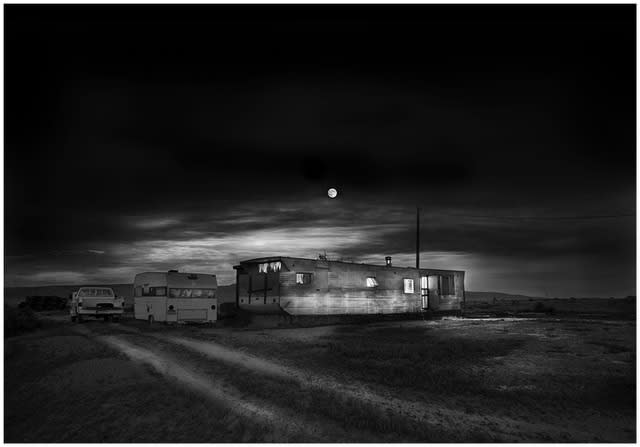
“Jack’s Place” by Teri Havens © Image provided courtesy of the artist
The beauty of the image was achieved only by following a very special traditional print making technique – platinum/palladium. Havens describes what she does – “In order to make a digital negative I size the image to the dimensions of the final print, then invert the image and print it onto a clear sheet of transparency film via an inkjet printer. Once the negative is finished the process is the same as with film. I go into the darkroom and make a contact print on a sheet of cotton watercolor paper which is hand coated with a palladium/platinum and light sensitizing emulsion. The finished print, a hybrid of modern digital technology and nineteenth-century printmaking techniques, reflects the context of the antiquated buildings – still alive, but barely – within contemporary society.” In her images, time is suspended and frozen.
Marcus Lyon, a UK photographer, is well-known for his production of beautifully detailed large scale collage work. His newest project, “Somos Brasil” (“We are Brazil”), is a very different endeavor in a number of ways. In a four year long project, Lyon traveled 22,000 km (approx. 13670 miles) across the entirety of Brazil to interview people who have had a positive impact on their communities and country. (He has a special connection to Brazil – his wife is Brazilian.) In his book there are 104 portraits of Brazilians selected from a population of over 200 million people. He sought out input from “people in their communities who represented agents of change”. He expanded the search to find “invisible people” who might not be readily known, but were a part of the deep complexity of Brazilian society. As a consequence, this monumental work, “Somos Brasil”, touches on a topic relative to today and a global flashpoint for discussion – migration and global expansion. The book shows exactly where he met with these individuals evidenced on an included map using a star to mark each location. He took their portraits and recorded conversations of them speaking. He then blended in a dose of technology. Lyon commissioned an image recognition app that would instantly activate the recorded conversations in Portuguese or in a voiced over English audio guide.
Lyon then went much further. He took DNA samples from each participant to determine from where each originated. As diverse a society and culture that is Brazil, it creates a unifying result. He has taken photography in a different direction by creating a volume we can hold, and take a visual journey through a country many of us may not know or visit, and walk away with a very personal encounter. Marcus was driven by the question of our identity. As Marcus commented in a 2016 TedXExeter talk: “Are they given or created”? He asked “Who are we and what can we become”. He further comments that life is a combination of acts and choices. There are other factors that influence our lives that we do not control and that make us each unique – our genetics, or DNA. For each portrait there is a global illustration of each person’s genetic origin. Roland Barthes quote above is from Barthes’ own reflection on a photograph. Lyon has taken Barthes’ comment that “The Photograph does not necessarily say what is no longer, but only and for certain what has been”, and adds scientific evidence of its truth, but no doubt not in a way that Barthes would have expected.
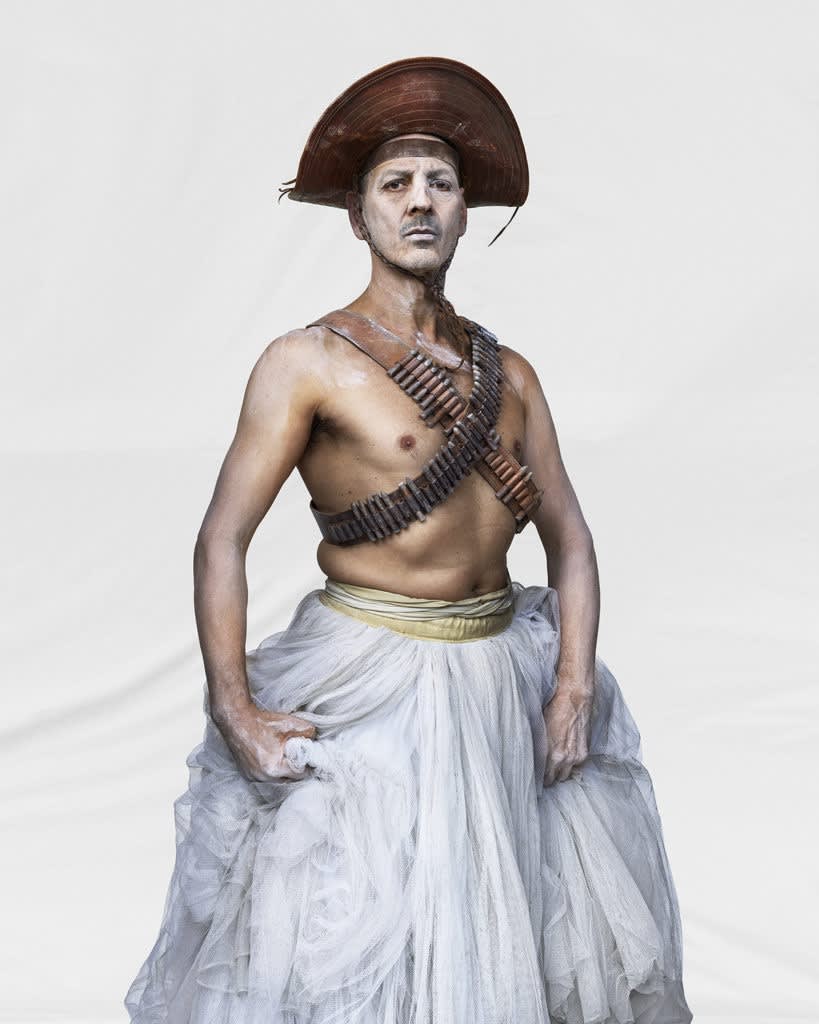

Marcus Lyon, in combining the science of DNA, recordings of the subject’s story in their own voice that can be replayed by the viewer, and taking their portraits as he had, has redefined portraiture. The book “Somos Brasil” includes an essay, “The invisibility of Origin”, by Martin Barnes, Senior Curator, Photographs, at the Victoria Albert Museum in London. Barnes describes the use of portraiture in the capture of human character and identity. He gives us a short history of photographers that, like Marcus Lyon, have used photography to memorialize a people. Starting with the beginnings of photography and Daguerrotypes in 1839, he speaks about Felice Beato (who in 1863 opened the first portrait studio in Japan), Alfred Martin Duggan-Cronin (who, between 1928 and 1954, photographed the Bantu Tribe of South Africa), Edward S. Curtis (who photographed North American Indians between 1907 and 1930), August Sander (his images of segments of German society in his 1929 “Face of our Time”) to Richard Avedon’s 1985 book “In the American West”. Lyon has taken this part of photography a whole step farther.
Lyon leverages the camera’s ability to “hold time”. Two of the persons he met and photographed are shown above. Jose Maria Carvalho Ferreira is a “butoh” dancer seeking to express to others a universality of man and connection to the world “beyond regionalism”. Mametu Nangetu/Oneide Monteiro Rodrigues is a “woman of roots”, a priestess of an Afro-Brazilian practice “candomblé”, who expends her energy against intolerance and prejudice. As Lyon said in his TedX talk, it “brings up a mirror to examine society”. The portraits are a visual illustration of the diversity of the Brazilian people.
Each of these highlighted photographers reflect the concept of time in a different way using a variety of techniques. Some artists worked in their studios. Some travel the world in the acquisition of images. Some used traditional film and “wet” dark room printing methods, while others were digital all the way. Where one captures a single image, others focus on creating compositions of multiple images. Composing one image from multiple exposures takes many forms – layering one image on another, montages of original images cut and assembled, or digitally assembled; but none appropriated. Each image had its own definition of time. In one image, time is specific as to day or night. In other images, time is lost; and in fact, without a visual reference point, timeless. Motion implies a movement through time. Roland Barthes stated: “The Photograph does not necessarily say what is no longer, but only and for certain what has been”. With collaged images, even though the image never was, as it is presented, Barthes’ statement would still apply.
Each individual image in the compositions selected and included in those bodies of work, are a visual memory of what once was, at one some prior point in time even though the image is a construction of many images. But that is the challenge and the opportunity in these more complex works. The viewer must examine more closely each component. What makes each of these photographers special is their ability to allow the viewer to embrace a lack of visual answers to any one question of time and place, and to think about many more.
